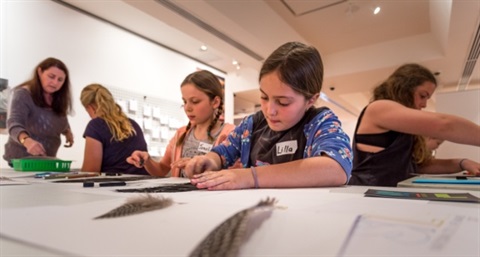Education kits

Education kits are available for some of our exhibitions to support school visits to the Gallery. The kits are designed to provide background information on the exhibitions, artists and different art forms. They can be used across a range of Education Stages.
Eugenia Lim: The Ambassador Education Kit
This resource offers suggested learning activities to help audiences engage with the practice of contemporary Australian artist Eugenia Lim. This resource will explore key ideas in Eugenia Lim's practice including:
• cultural identity
• migration and globalisation
• characters
• national and personal histories
While these activities have been written with late primary and early secondary students in mind, the concepts they address are intended to be accessible and adaptable to learners of all ages and abilities. Teachers are free to adapt these learning activities to suit their context and their students. That said, this section connects to the subject areas of Visual Arts and History (or HASS), with particular relevance to the Australian Curriculum cross-curriculum priority of Asia & Australia's engagement with Asia.
The activities contained in this resource are aimed to be used flexibly and may be undertaken before, during or after an exhibition visit. Teachers could also combine learning experiences to deliver a larger unit of work that has the potential to cover both Arts and HASS outcomes.
In this resource, you will find:
• Insight into the practice of Eugenia Lim
• A contextual timeline of Australia's engagement with China
• A glossary of terms
• A variety of discussion and making activities for use in the classroom, or the gallery.
• Links for further reading and exploration.
Click here(PDF, 3MB) to access the Eugenia Lim Education Kit.
|
|
STILL: National Still Life Award 2017 Education Kit
This K-12 education resource has three components. There are two PowerPoint Slideshows ‘Still Life — A History’ and ‘STILL 2017 Exhibition’ and one document of ‘Still Teachers’ Notes and Activities’. All of these are also saved as PDFs for ease of printing.
The first PDF ‘Still Life — A History’ gives a definition and context for the genre of Still Life in western art history. The PDF shows historical examples of still life which connect to the contemporary responses to still life found in the Still exhibition.
The second PDF ‘STILL: The Artists 2017’ focuses on sixteen contemporary Australian artists selected from the more than sixty artists featured in the exhibition. The PDF shows a slide of the artist’s work and their artist statement. The images are grouped by four themes: Illusion, Symbolism, Personal & Political, Identity.
The document ‘Education Resource for Teachers’ is designed to accompany the PDFs. The notes can be printed out or used as an adjunct to the slideshows. The notes feature questions (Q) and activities (A) for primary age students and secondary age students grouped by the four themes.
The teachers’ notes also include an “Introduction to the Genre of Still life” which relates to the information found in the first slide show and background information about the National Still Life Award.
This education resource was commissioned and supported by Bryant McKinnon Lawyers. Special thanks go to Heather McKinnon for her ongoing support of the arts and education in the Coffs Harbour region.